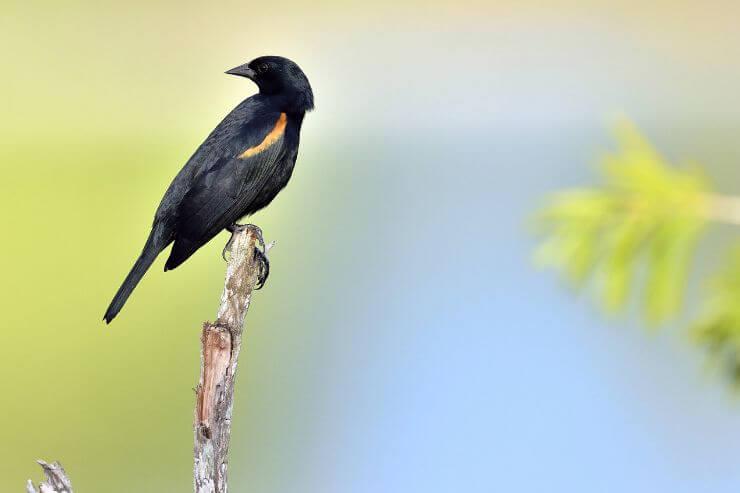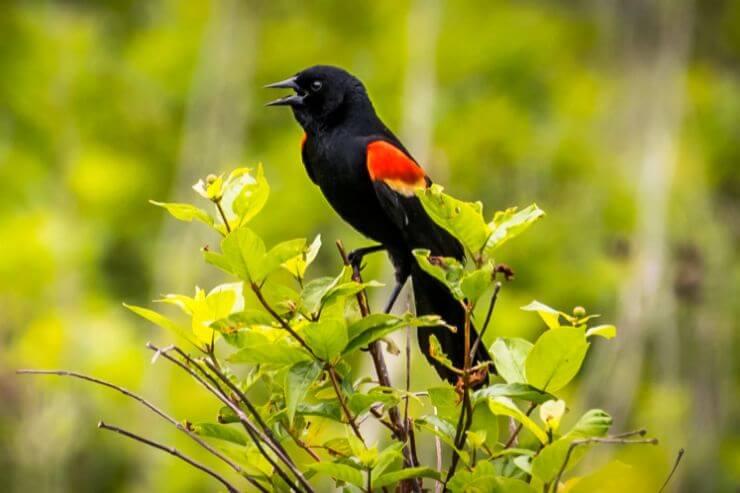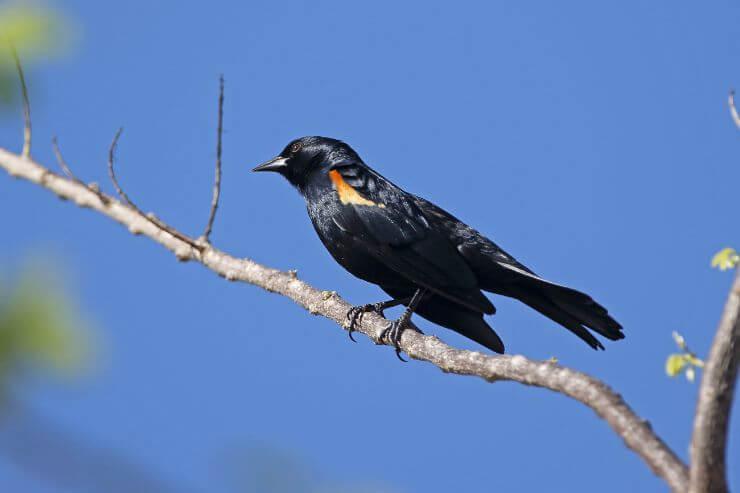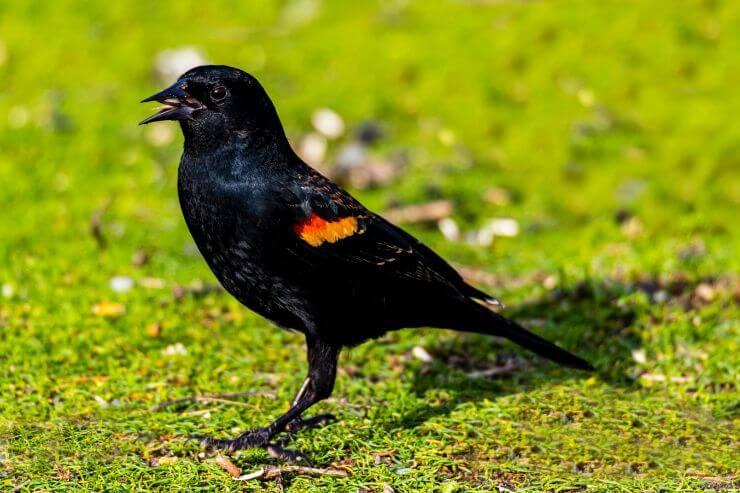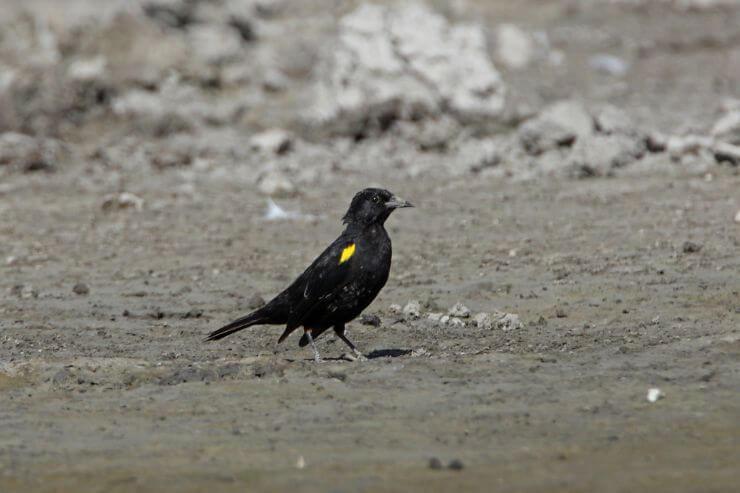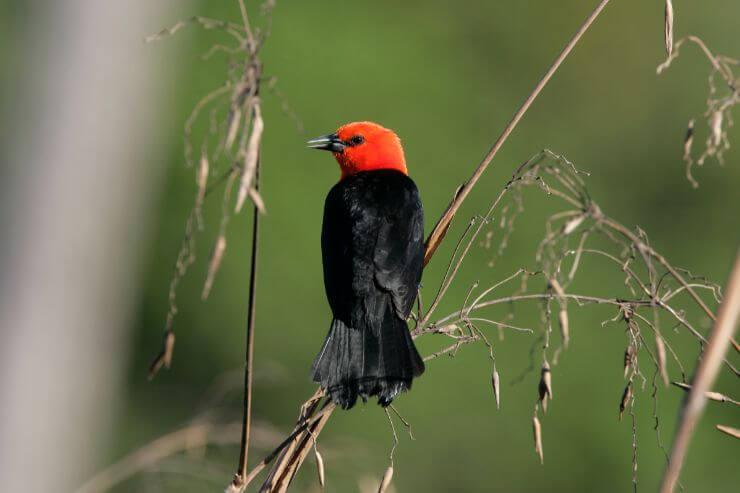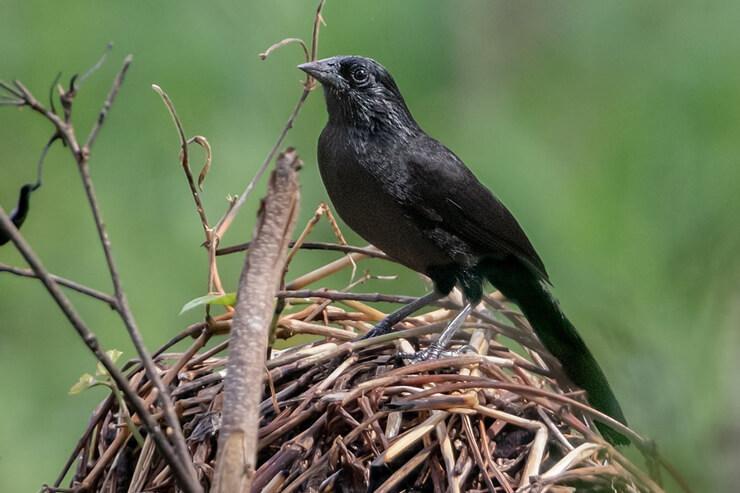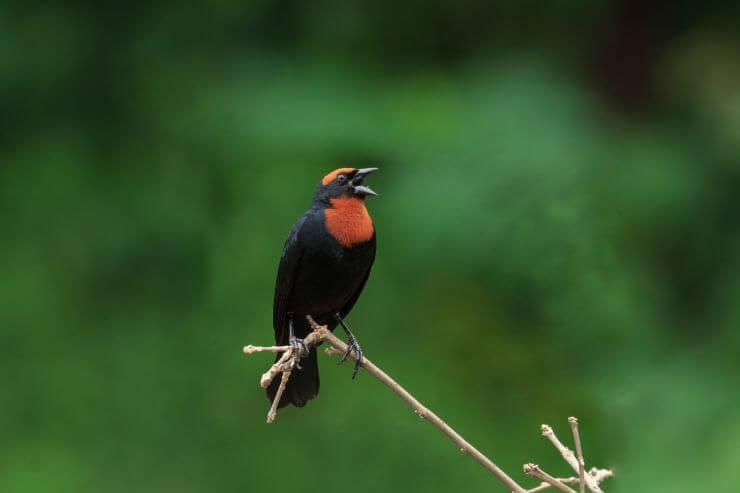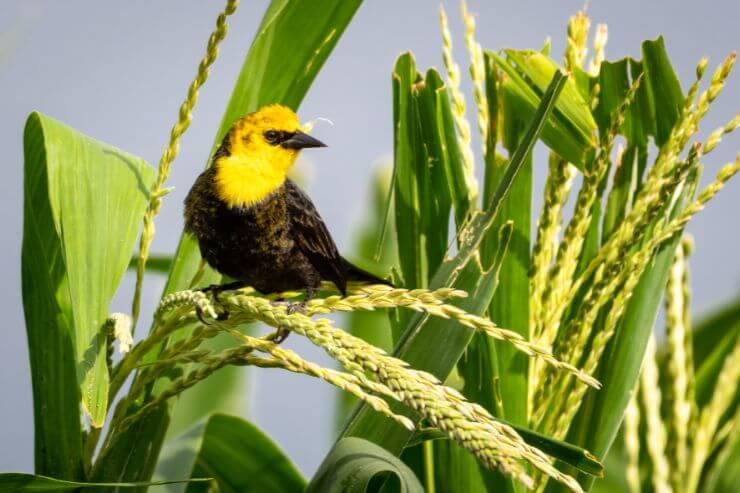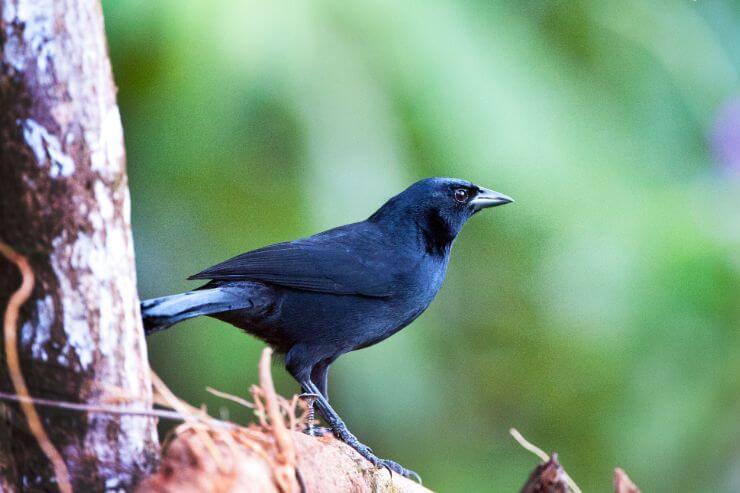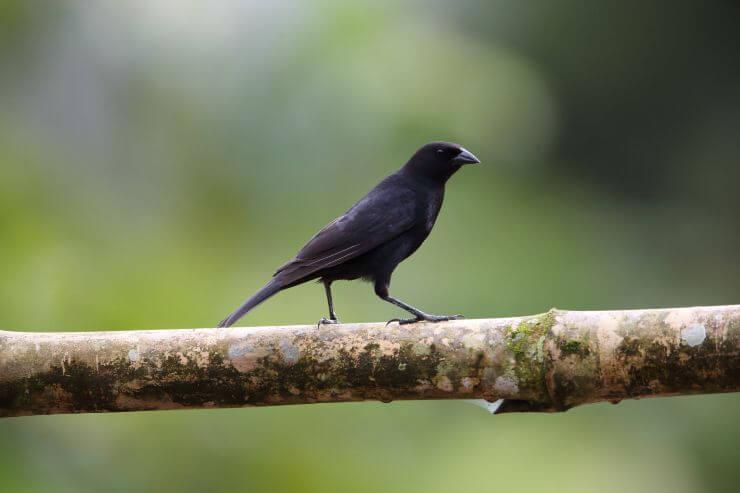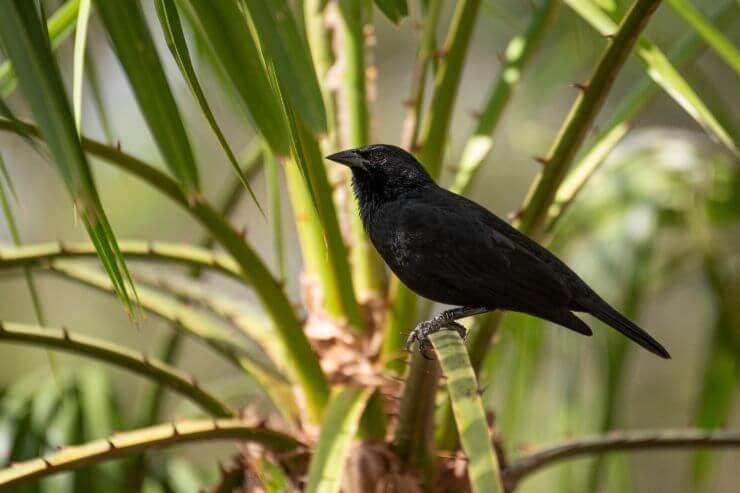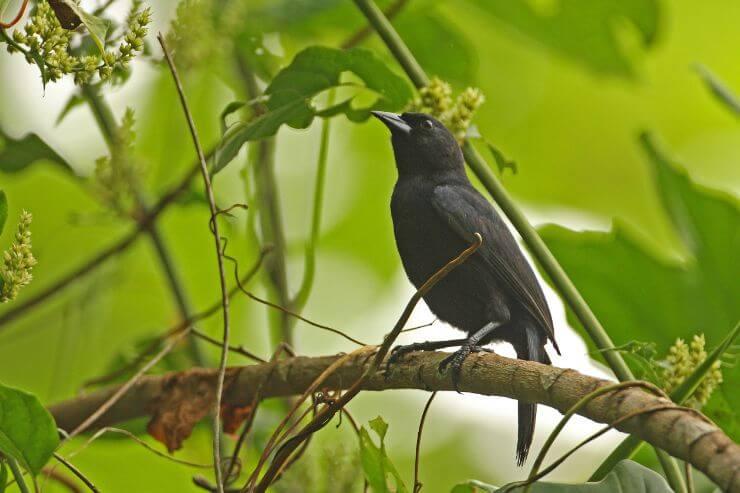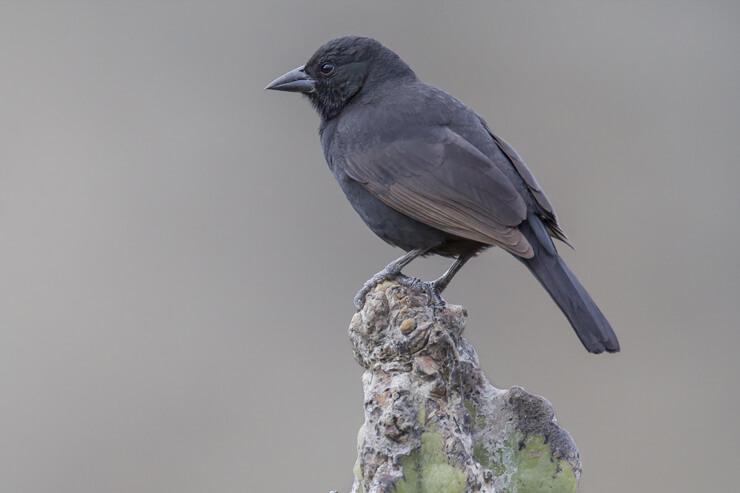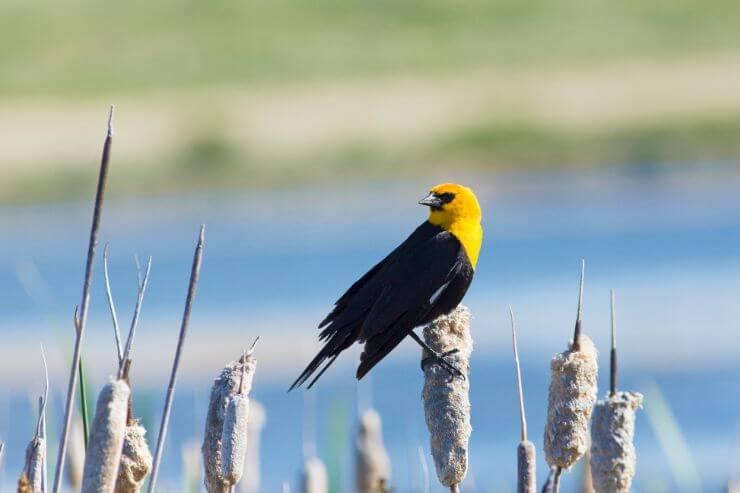Blackbirds are a group of New World birds that belong to the family Icteridae and look very similar to the Eurasian blackbird, which is actually a thrush. New World blackbirds have long, tapered bills, allowing them to feed predominantly on seeds and eat many insects.
They normally forage on the ground, but some species forage in trees.
Sexual dimorphism is present in many species, with males generally being black with spots of color and females being dull and brown. Many species gather during the winter to form huge feeding flocks, sometimes consisting of multiple blackbirds and other related bird species.
There are 23 species of blackbirds grouped into 14 genera, all described in the following article.
The male red-shouldered blackbird has smooth black plumage with a bluish iridescence. He also has an orange-red shoulder patch with a yellow outline. Females are less shiny and plain black without shoulder patches.
They are endemic to Cuba, where they live in marshes, wetlands and swamps.
The breeding male red-winged blackbird is a glossy black bird with a yellow stripe on the wing and an orange-red spot on the shoulder. In non-breeding plumage, they have rusty edges on the feathers and smaller patches on the shoulders.
Females have smooth brown upperparts, heavily brown-striped underparts, and pale eyebrows. Small patches are also seen on the shoulders.
They are found in almost all of North America and most of Central America, where it is one of the most abundant birds. They live in marshes and scrub fields.
The tawny-shouldered blackbird has shiny black plumage and an orange-yellow shoulder spot. The female is similar to the male but has less shine and a smaller shoulder patch.
They live in many types of habitats, including forest edges, grasses, scrublands, and fields. They have a small distribution, limited to Cuba and Hispaniola.
The tricolor blackbird is a small black bird with white stripes on its wings. The breeding male is shiny black, except for the orange-red spot on the shoulder.
Non-breeding males are duller. The female is generally dull dark brown with stripes on the underside.
They are found in marshes, wetlands, grasslands, and fields on the west coast of the United States and Baja California in Mexico.
The yellow-shouldered blackbird is completely black except for the yellow shoulder patch. Males and females are equal.
They are only found in Puerto Rico. They inhabit mangroves and adjacent bushes.
The pale-eyed blackbird has shiny black plumage with a pale yellow or white eye. The sexes are similar.
They live in moist grasslands and marshes around oxbow lakes and lagoons in their restricted range within Peru and Ecuador.
Male blackbirds are simple black birds. Females show geographic variation with black-striped brown to olive-brown upperparts.
Its underside is dark yellow to olive with brown veins. They have a yellow eyebrow stripe and a dark facial mask.
They occur in swamps, grasslands and marshes. They are found in South America, mainly in central.
The male yellow-winged blackbird is a black bird with yellow on the wings forming a patch on the shoulder.
The female has a dark brown upperpart, a pale eyebrow stripe, a dark brown facial mask, and a light brown underside with dark stripes.
They are found in southern South America and inhabit wetlands, lake edges, swamps, pastures and fields.
The scarlet-headed blackbird is a beautiful blackbird with a bright orange-red head, neck, throat, chest, and thighs. The sexes are similar.
They live in marshes with dense vegetation and are found in Argentina, Paraguay, Brazil, Uruguay and Bolivia.
Forbes’ blackbird has black plumage all over its body. The males are similar to the females.
They live in forest edges, adjacent marshes, flooded grasslands and sugar cane plantations. They have a restricted distribution area in the northeast and east of Brazil.
Male Brown-Capped Blackbirds in breeding plumage have black plumage, except for the throat, forehead and crown, which are brown. In non-breeding plumage, they have olive-tipped feathers on the back, flanks and breast.
Females have a dark olive-brown face and finely streaked upperparts, a beige throat, and dark-streaked olive-brown underparts.
They live in moist grasslands, marshes and agricultural lands. They occur throughout east-central South America.
The breeding male Yellow-hooded Blackbird is an unmistakable bird with a bright yellow head, breast and nape contrasting with the black body. In non-breeding plumage, males look similar but have yellow-tipped breast and back feathers and an olive-yellow nape and crown.
The female looks different, with a yellowish head, a brighter yellow upper breast, blackish wings, and a dark olive-brown color on the rest of the body with some stripes.
They are found in northern South America. They live in wetlands, marshes, around lakes and along rivers.
Female and male southern blackbirds have shiny black plumage all over their bodies.
They live in many habitats, including croplands, urban parks, open woodlands, and shrublands. This species is found in Chile and Argentina.
The songbird has velvety black plumage. The sexes are similar.
This blackbird is found in Central America and is found in semi-open habitats such as open forests, agricultural lands, yards, and adjacent fields near forests.
The Blackbird Scrub is overall black with a bluish sheen. The males and females look alike.
They live in open areas and lowland forests of western Ecuador, western Peru and southwestern Colombia.
Male Brewer’s Blackbirds in breeding plumage have shiny black plumage with a purple sheen on the head, a greenish sheen on the body, and yellow eyes. Non-breeding males have a pale eyebrow stripe.
Females have dark brown plumage, a delicate purple sheen on the head, a greenish sheen on the body, and a dark eye line.
They inhabit open areas, including fields, farmland, parks, and urban environments. They are found in most of the United States, Mexico, and southwestern Canada.
The breeding male Rusty Blackbird has black plumage with a bright green sheen. In non-breeding plumage, the male has a buff-brown eyebrow stripe, a rusty-brown nape, crown and ears, and rusty feather edges. The underside is buff brown with black bars. The upperpart is mainly brown, with a black rump, tail and wings. They have yellow eyes in all plumage phases.
Females are slate gray with rusty feather edges, buff-brown eyebrow stripes, brown heads and breasts, and dark upperparts showing a bluish-green sheen.
They are found in most swamps, peat bogs, coasts, wet forests, cultivated areas, pastures, and wooded fields in North America.
The Chopi blackbird has completely shiny black plumage. The females look like the males.
They occur at forest edges, in forests, grasslands, savannahs and agricultural areas. They are found in much of central and eastern South America.
Male Jamaican blackbirds have completely shiny black plumage. The females look like the males.
They inhabit high altitude moist montane forests and wet forests, and are endemic to Jamaica.
The Bolivian blackbird is a smooth black bird with brown wings. The males and females look alike.
They are found in agricultural areas, forests, cactus forests, scrublands and agricultural areas in dry valleys of the Andes of Bolivia.
The Cuban blackbird has shiny black plumage with shades of blue, violet and blue-green. The female is duller than the male.
They are found in various woodland habitats, such as moist forests, yards, parks, wooded cities, grasslands, open forests, fields and human settlements. This species is endemic to Cuba.
The yellow-headed blackbird is aptly named, the male being a black bird with a white stripe on the wing and a golden-yellow head, neck and breast.
Females have a drab appearance, with dark brown bodies, dull yellow breasts, and irregular black and yellow heads.
They occur in western North America and Mexico, primarily in swamps, wetlands, grasslands, and edges of rivers and ponds.
The saffron hooded blackbird has a yellow head, rump, shoulders and underside, while the rest of the body is black, including the black facial mask. Females have a similar pattern to males, but have brown feathers, while males have black feathers.
They live in grasslands, pastures and marshes. Its small range is found in Argentina, Brazil, Paraguay and Uruguay.
Blackbirds are an interesting group of birds with black plumage, shiny tones and colorful spots that vary depending on the species.
The conservation status of blackbirds varies from those that are very abundant to those whose populations are rapidly declining.
Blackbirds are threatened by habitat destruction due to land conversion, habitat fragmentation, poisoning and competition, all made worse by the small areas in which some species live.
